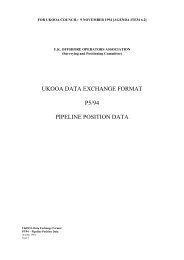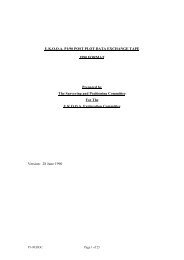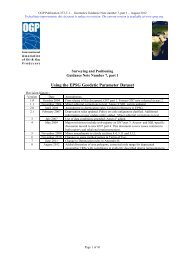1065 - OGP Surveying and Positioning Committee
1065 - OGP Surveying and Positioning Committee
1065 - OGP Surveying and Positioning Committee
Create successful ePaper yourself
Turn your PDF publications into a flip-book with our unique Google optimized e-Paper software.
_____________________________________________________________________________________________________________________Page 18Defined dataFrom the 1 st January 2000, the UKCS petroleum licence boundary co-ordinates suppliedeither as numbers or in map form will have to reflect the clarifications contained in the Gazettenotice. This type of spatial data can be classified as defined data. Except for the co-ordinatesof licences in the tier immediately west of the Thunderer line (see annex C), blocks <strong>and</strong>quadrants retain the corner co-ordinates that they have always had. Licence boundary coordinatesfor licences to the east the Thunderer line are in ED50 terms, whilst those forlicences to the west of the line are in ETRF89 terms.Measured dataEast of the Thunderer linei. The recommended relationship between ED50 <strong>and</strong> WGS 84 or ETRF89 forpetroleum exploration purposes has now been defined as the “Common Offshore”transformation detailed in the Gazette notice. However, it is recognised that slightlydifferent transformations have been used historically. In general, for oil exploration<strong>and</strong> production purposes the results of these transformations are not significantlydifferent <strong>and</strong> can be ignored, but if known, they should be documented.ii.In certain cases involving existing unitisation across licence boundaries it will benecessary to retain the use of the transformation adopted by the unit operator toensure that there is no change in equity attributable to revised co-ordinate systempractices.West of the Thunderer Linei. Whether the decision is made to "transform or not", it is important to always supplyfull reference, digitally <strong>and</strong>/or in hard copy concerning the co-ordinate system towhich the spatial data refers. Existing measured data must be fully documented.ii.iii.iv.Existing data (seismic, well) positioned using GPS may have had an inappropriatedatum transformation applied. If so the datum transformation should be reversed.Existing data positioned by Transit may have had an inappropriate datumtransformation applied. This should be reversed <strong>and</strong> if a positioning accuracy ofbetter than 15m is required the DMA WGS72 Broadcast Ephemeris to WGS 84transformation applied.Existing data positioned by radio-navigation (e.g. Pulse/8) may not have had anappropriate datum transformation applied. If a positioning accuracy of better than150m is required the so-called ED50 position (whatever that means) should beconverted to ETRF89 by applying the Common Offshore transformation in reverse.GenerallyIt is recommended that all existing stocks of published maps, plans, transparencies <strong>and</strong>reports that may contain legacy data that could be considered affected should be stampedwith the following warning:"The graticule or geographic co-ordinates shown on the UKCS portion of this mapwest of longitude 6degW (the Thunderer Line) are no longer current. If shown,Petroleum licence block boundaries <strong>and</strong> other data may be incorrectly depicted in thisarea. The datum used to control this portion of the map should be the EuropeanTerrestrial Reference Frame 1989 (ETRF89).” If applicable, this should besupplemented with the additional statement indicating a contact point, “For furtherinformation contact....".____________________________________________________________________________________________UKOOA Guidance Notes on use of co-ordinate systems in data management on the UKCS. November 1999






